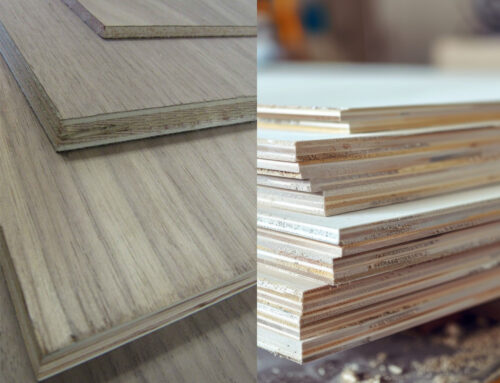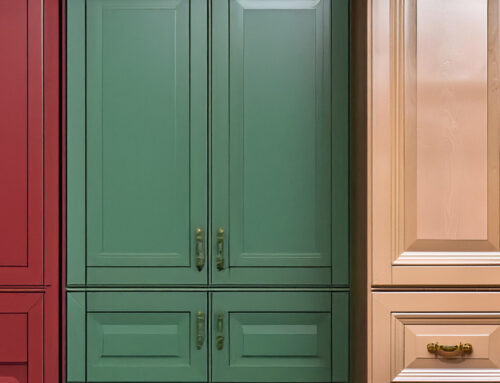When considering kitchen updates, homeowners often weigh the options between cabinet replacing and cabinet refinishing. Each approach offers distinct advantages and drawbacks. To help you decide, let’s delve into the specifics of both options, highlighting their impact on cost, quality, and home value.
Cabinet Refinishing: Economical but with Compromises
Cabinet refinishing is appealing primarily for its lower up-front cost. This method involves sanding and repainting or staining your existing cabinets. It’s a budget-friendly choice but comes with several potential issues:
- Debris in Finish: Refinishing work done onsite can lead to debris and dust particles embedding in the finish, which can affect the smoothness and appearance of your cabinets.
- Hardware and Fit Issues: Using old doors or non-custom replacements can lead to improper fit, resulting in gaps and misalignment. Also, retaining old hardware might lead to functional problems, such as misaligned doors and problematic hinges.
- Time and Inconvenience: The refinishing process can be lengthy, often stretching over several days or weeks. During this time, the ongoing work spreads debris and dust throughout the home, which can strain your home’s air filtration system and add to the overall inconvenience.
- Labor Intensive: The process of refinishing cabinets in labor-intensive, involving meticulous sanding, prepping, and painting. This extensive manual effort can lead to higher labor costs as professionals must address each cabinet individually to ensure a uniform appearance. These steps are crucial to achieving a high-quality finish but can significantly increase the overall cost of the refinishing project.
Cabinet Replacing: A Worthwhile Investment
Replacing cabinets, though more costly, offers considerable benefits that often outweigh the initial investment, especially when upgrading from builder-grade to semi-custom cabinets or custom cabinets.
- Enhanced Quality and Customization: New cabinets are manufactured in controlled environments, ensuring cleaner finishes free of debris. Custom-built options perfectly fit your kitchen’s dimensions, optimizing space and aesthetics.
- Advanced Hardware: New cabinets incorporate the latest in hardware technology, including soft-close mechanisms and sturdy construction, enhancing both functionality and durability.
- Efficiency in Installation: Preparation and finishing of new cabinets are handled offsite, leading to quicker and less disruptive installations.
- Revealing Hidden Damages: Replacement allows for the discovery and repair of any hidden damages behind old cabinets, crucial for maintaining your home’s integrity.
- Countertop Considerations: Replacing cabinets often means installing new countertops, providing the opportunity to fully redesign your kitchen’s aesthetic. This can be limiting when refinishing, as the existing countertops may dictate the color and style choices for the refinished cabinets.
- Functional Improvements: Replacing cabinets allows for redesigning the kitchen’s layout and functionality. This could include installing pull-out garbage cans, adding more drawers, or incorporating a built-in spice rack, which can dramatically enhance the kitchen’s usability.
Long-Term Satisfaction and Value
While refinishing is more affordable, it often is more disruptive and leads to less satisfaction due to the limitations of older materials and designs. Moreover, the imperfections that often accompany a refinishing job, such as uneven finishes or lingering hardware issues, might eventually lead to the desire to redo the cabinets entirely, thereby incurring additional expense.
The higher initial investment in new cabinets can prevent future expenditures, as the likelihood of needing to redo the work due to quality issues is significantly lower. Moreover, enhancing your kitchen with high-quality cabinets and functional improvements adds significant value to your property, making it more appealing for resale.
Conclusion
Carefully assess your kitchen’s current condition, your budget, and your goals for home improvement. While refinishing may appear more cost-effective initially, it often requires extensive labor for sanding, prepping, and painting, which can add unforeseen expenses to the overall project cost. Moreover, the limitations of older materials and potential dissatisfaction due to imperfections may lead to additional future expenditures to redo the work.
On the other hand, replacing cabinets offers a transformative renovation that enhances both the kitchen’s function and the home’s overall value right from the start. Although the upfront cost is higher, it minimizes the likelihood of incurring future redo costs and adds significant resale value to your property. For those seeking a comprehensive upgrade with lasting benefits, replacing cabinets is the recommended choice.




Leave A Comment